Instruction
Look to a pitcher’s mechanics to help with your swing
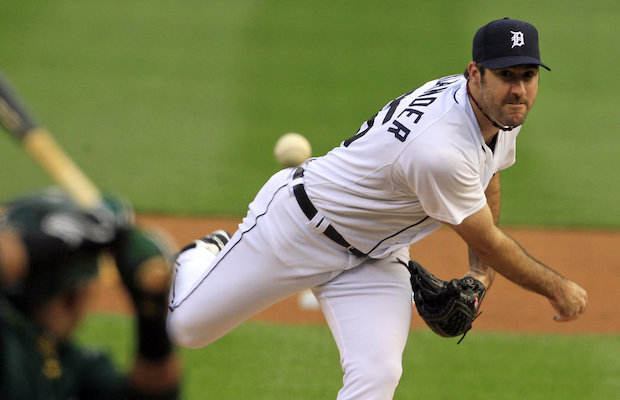
Baseball is back with all the traditions and fanfare that go along with Spring Training. Cactus and Grapefruit leagues opened on Thursday and most veterans will be bringing their golf clubs with them. Golf has long been a hobby of big league ball players and as a rule, pitchers have consistently had the lowest handicaps. Position players might attribute their pitching teammates’ golfing skill to their once-every-five-day work schedules, but it probably doesn’t hurt that certain core fundamentals of the pitching motion are common to the golf swing as well.
Look at Justin Verlander’s delivery and Thorbjorn Olesen’s golf swing below to see just how similar their moves are — and how they can help your golf swing gain power and accuracy.
At the top of a pitcher’s rotation his weight must be balanced above, but not behind his back foot.
Exactly like in a golf swing, the forward weight transfer can only be done effectively so long as the weight stays between the feet. Verlander is clearly balanced over his right leg, but there is still a slight lean toward home plate leaving no restrictions from moving his energy forward. Imagine the similarities between a third baseman throwing to first base from his knees and a golfer swinging from his back foot: the ball flight for both will be weak, high and inaccurate.
A pitcher’s delivery starts by unwinding his hips as he strides toward home plate.
As the hips unwind, they naturally pull the torso and then the arm through the delivery zone. This is old news for most golfers but certainly worth revisiting: Every good golf and pitching motion leads with the hips! Pitchers and golfers both derive the majority of their power from their legs and hips and Verlander is of course no different. You can see his belt buckle is nearly 90 degrees ahead of his chest and quite similar to Olesen’s golf swing.
At the “release” point of his delivery a pitcher’s arm and “brake leg” are fully extended to send the ball to the batter with maximum velocity.
Just like the point of impact in a golf swing, a pitcher’s leading leg and throwing arm are fully extended. The arm motion is intuitive for most — all other things being equal a longer hitting/throwing implement will generate more speed.
The “brake” or front leg, when straightened, stops the forward momentum generated by the back leg. Look at how Verlander’s leg is actually hyperextended; this allows energy to be transferred to the ball from a position of strength and stability. Should the brake/front leg continue forward, energy will not be transferred efficiently and an “energy leak” will occur. This could be the biggest difference between high- and low-handicap golfers: many golfers slide their legs through impact and do not have a strong brake leg to continue turning their swing around. Sliding through impact can also lead to slicing and inefficient contact in your golf swing.
This “braking” motion is what aggravated Tiger Woods’ leg injury in the 2008 U.S. Open. That he continued to sturdily plant his brake leg in spite of the immense pain it caused should be testament enough to how important it is in the golf swing. Casey Martin is another prime example of how important this move is to creating power. Famous for needing a cart to play on the PGA Tour due to a congenital defect that left his right (back) leg weak and withered, Martin acknowledged with absolute certainty that he would have had a completely different swing had it been his left (brake) leg that was affected by his condition.
A pitcher’s delivery is not complete until his whole body is facing the target.
Just like your belt buckle is supposed to face the target at the end of your swing so should a pitcher be squared up to home plate after he has thrown the baseball. Finishing a swing properly is set up by a strong brake leg and demonstrated beautifully by Olesen in this picture.
All of the best motions are pointless if they are in the wrong sequence.
I alluded to this earlier with the hips-leading-torso-leading-arms relationship, but it bears repeating. An easy way to remember all of this is that the golf swing sequence radiates from your center. Hips are nearest your center and lead the downswing, initiating the unwinding of your torso. As your torso begins to unwind the arms start to move as well. Fred Couples is a great example of sequence in a golf swing. You can see his hips “bump” forward just barely before his shoulders and arms stop swinging back.
My teaching philosophy incorporates many different sports and is tailored to each student’s athletic history. The golf swing is an athletic motion and it is important to relate it to what you already know and in the athletic world throwing a ball is about as simple and common as it gets. Most golfers I have worked with have a general understanding of throwing mechanics and might be able to apply some of these concepts to their own swing. Even more valuable is the notion that you can use your knowledge of throwing mechanics (or other sports you’re more familiar with) as an elementary guide to diagnosing swing problems, too.
Play ball!
- LIKE13
- LEGIT0
- WOW0
- LOL0
- IDHT0
- FLOP0
- OB0
- SHANK0
Instruction
Clement: Laid-off or perfect fade? Across-the-line or perfect draw?

Some call the image on the left laid off, but if you are hitting a fade, this could be a perfect backswing for it! Same for across the line for a draw! Stop racking your brain with perceived mistakes and simply match backswing to shot shape!
- LIKE0
- LEGIT0
- WOW0
- LOL0
- IDHT0
- FLOP0
- OB0
- SHANK1
Instruction
The Wedge Guy: The easiest-to-learn golf basic

My golf learning began with this simple fact – if you don’t have a fundamentally sound hold on the golf club, it is practically impossible for your body to execute a fundamentally sound golf swing. I’m still a big believer that the golf swing is much easier to execute if you begin with the proper hold on the club.
As you might imagine, I come into contact with hundreds of golfers of all skill levels. And it is very rare to see a good player with a bad hold on the golf club. There are some exceptions, for sure, but they are very few and very far between, and they typically have beat so many balls with their poor grip that they’ve found a way to work around it.
The reality of biophysics is that the body moves only in certain ways – and the particulars of the way you hold the golf club can totally prevent a sound swing motion that allows the club to release properly through the impact zone. The wonderful thing is that anyone can learn how to put a fundamentally sound hold on the golf club, and you can practice it anywhere your hands are not otherwise engaged, like watching TV or just sitting and relaxing.
Whether you prefer an overlap, interlock or full-finger (not baseball!) grip on the club, the same fundamentals apply. Here are the major grip faults I see most often, in the order of the frequency:
Mis-aligned hands
By this I mean that the palms of the two hands are not parallel to each other. Too many golfers have a weak left hand and strong right, or vice versa. The easiest way to learn how to hold the club with your palms aligned properly is to grip a plain wooden ruler or yardstick. It forces the hands to align properly and shows you how that feels. If you grip and re-grip a yardstick several times, then grip a club, you’ll see that the learning curve is almost immediate.
The position of the grip in the upper/left hand
I also observe many golfers who have the butt of the grip too far into the heel pad of the upper hand (the left hand for right-handed players). It’s amazing how much easier it is to release the club through the ball if even 1/4-1/2″ of the butt is beyond the left heel pad. Try this yourself to see what I mean. Swing the club freely with just your left hand and notice the difference in its release from when you hold it at the end of the grip, versus gripping down even a half inch.
To help you really understand how this works, go to the range and hit shots with your five-iron gripped down a full inch to make the club the same length as your seven-iron. You will probably see an amazing shot shape difference, and likely not see as much distance loss as you would expect.
Too much lower (right) hand on the club
It seems like almost all golfers of 8-10 handicap or higher have the club too far into the palm of the lower hand, because that feels “good” if you are trying to control the path of the clubhead to the ball. But the golf swing is not an effort to hit at the ball – it is a swing of the club. The proper hold on the club has the grip underneath the pad at the base of the fingers. This will likely feel “weak” to you — like you cannot control the club like that. EXACTLY. You should not be trying to control the club with your lower/master hand.
Gripping too tightly
Nearly all golfers hold the club too tightly, which tenses up the forearms and prevents a proper release of the club through impact. In order for the club to move back and through properly, you must feel that the club is controlled by the last three fingers of the upper hand, and the middle two fingers of the lower hand. If you engage your thumbs and forefingers in “holding” the club, the result will almost always be a grip that is too tight. Try this for yourself. Hold the club in your upper hand only, and squeeze firmly with just the last three fingers, with the forefinger and thumb off the club entirely. You have good control, but your forearms are not tense. Then begin to squeeze down with your thumb and forefinger and observe the tensing of the entire forearm. This is the way we are made, so the key to preventing tenseness in the arms is to hold the club very lightly with the “pinchers” — the thumbs and forefingers.
So, those are what I believe are the four fundamentals of a good grip. Anyone can learn them in their home or office very quickly. There is no easier way to improve your ball striking consistency and add distance than giving more attention to the way you hold the golf club.
More from the Wedge Guy
- The Wedge Guy: Golf mastery begins with your wedge game
- The Wedge Guy: Why golf is 20 times harder than brain surgery
- The Wedge Guy: Musings on the golf ball rollback
- LIKE88
- LEGIT14
- WOW6
- LOL1
- IDHT0
- FLOP4
- OB1
- SHANK8
Instruction
Clement: Stop ripping off your swing with this drill!

Not the dreaded headcover under the armpit drill! As if your body is defective and can’t function by itself! Have you seen how incredible the human machine is with all the incredible feats of agility all kinds of athletes are accomplishing? You think your body is so defective (the good Lord is laughing his head off at you) that it needs a headcover tucked under the armpit so you can swing like T-Rex?
- LIKE0
- LEGIT3
- WOW2
- LOL0
- IDHT0
- FLOP0
- OB0
- SHANK2
-

 19th Hole2 weeks ago
19th Hole2 weeks agoJustin Thomas on the equipment choice of Scottie Scheffler that he thinks is ‘weird’
-

 19th Hole2 weeks ago
19th Hole2 weeks ago‘Absolutely crazy’ – Major champ lays into Patrick Cantlay over his decision on final hole of RBC Heritage
-

 19th Hole3 weeks ago
19th Hole3 weeks agoTwo star names reportedly blanked Jon Rahm all week at the Masters
-

 19th Hole3 weeks ago
19th Hole3 weeks agoReport: LIV Golf identifies latest star name they hope to sign to breakaway tour
-

 19th Hole3 weeks ago
19th Hole3 weeks agoNeal Shipley presser ends in awkward fashion after reporter claims Tiger handed him note on 8th fairway
-

 19th Hole2 weeks ago
19th Hole2 weeks agoBrandel Chamblee has ‘no doubt’ who started the McIlroy/LIV rumor and why
-

 19th Hole1 week ago
19th Hole1 week agoLET pro gives detailed financial breakdown of first week on tour…and the net result may shock you
-

 Equipment3 weeks ago
Equipment3 weeks agoJason Day on his recent switch into Srixon ZX5 and ZX7 Mk II irons

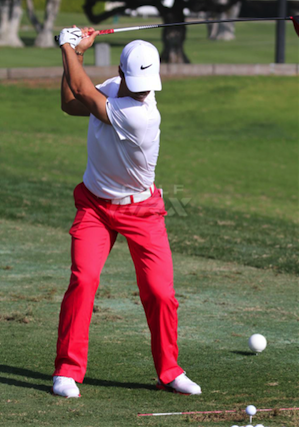

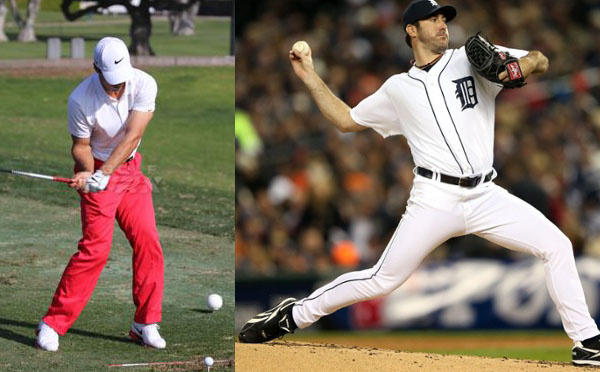


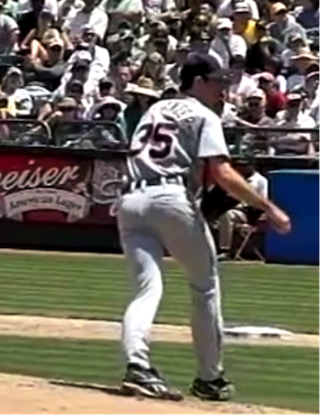
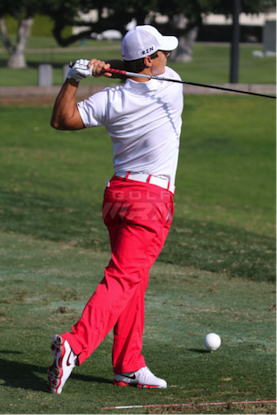

















Jeff
May 24, 2015 at 10:25 pm
Ok, it’s worth noting here that in baseball, basketball, boxing, any sport in which the player uses the ground for leverage to create power, none of the instruction focuses on that body movement, and it happens naturally, that’s why it’s fluid.
While good golf swings marry up with good pitching mechanics, thinking about pitching a baseball is a good way to miss your golf ball entirely, because it will make you take too big of a backswing and never get back to the ball in the same place.
Randy
Feb 17, 2014 at 1:58 pm
Well, that’s partly right, John. Hogan’s analogy to an infielder throwing to first base after fielding a ground ball is meant specifically to demonstrate the approximate motion of the trail arm in the downswing (see p. 97 in Simon & Schuster’s paperback edition of “Five Lessons”). It doesn’t cover the entire process of weight transfer, leverage, and sequencing, which was the focus of the article above.
Jack Nash
Feb 17, 2014 at 1:01 pm
Actually I throw like a pitcher when I want to improve my lie 😉
John
Feb 17, 2014 at 11:56 am
Eric – such a great article here. An old track and field coach of mine and I were flipping through photo sequences of good Javelin throwers; the exact same set of principles apply.
Eric Johnson
Feb 18, 2014 at 1:15 am
Thanks John for the compliments and also for another terrific example. Just what I was hoping to see in the comments!
Rod
Feb 15, 2014 at 11:48 pm
Amazing that you picked Verlander for this article…he is an avid golfer, quite a fine player in fact, and he KILLS it…Absolute TOUR length, probably well above average length on TOUR.
parker
Feb 14, 2014 at 11:39 pm
What if I am a left handed golfer but throw a ball with my right hand and am right hand dominant? Does this mean I should be golfing right handed to relate to the natural throwing motion, or should I stay with my left hand dexterity because it’s closely related to my baseball swing? Which is better, the throwing motion or the hitting motion to imitate? I’ve struggled with which way to golf all my life and have come up with some good arguments for both dexterities.
Eric Johnson
Feb 15, 2014 at 11:16 am
Parker – unless you are a very young golfer (13 or under) or have only been playing for a few months I would not recommend switching from one hand to the other. I can actually relate to you here – I throw and swing righty but my LH golf swing is technically superior to my right. Anyway – to answer your question of which is better to imitate my answer should already by clear: throwing! But instead of your arm motion specifically I think you should focus more on how the pitching motion delivers power through legs, hips and their relationship to your torso. This is affirmed by looking at Titleist Performance Institute’s recommended exercises. Nearly all of them are compound exercises and almost none of them isolate arms specifically. So, focus on using your legs and torso together and let your arms and hands follow along. You may have to use your imagination a bit to “mirror” what you already do to throw a ball but this is the more effective way to model your swing.
parker
Feb 18, 2014 at 1:22 am
Thanks Eric for the response and advice. I’m not a beginner nor a child (29) but I have switched from right handed to a left handed golf swing 5 years ago and have become a single digit handicapper. Along my travels of progression I began to realize my right handed golf swing was very fundamentally correct and started to learn and borrow from it to apply to my left handed swing. My left handed swing is now pretty good but am concerned nothing fundamentally came naturally, it was all manufactured by my gathering of knowledge. This leads me to believe maybe I could have more upside if I went back to right handed. I often wonder if I put in the same effort in progression that I previously did, would my swing be better than it already is. I find myself toying with buddies clubs wondering if I’m missing out on some future betterment and whether or not to switch yet again.
John Brotherton
Feb 14, 2014 at 2:34 pm
I think a short stop side arm throw is a more accurate analogy than a pitcher. Hogan details this in his book as well. Just saying!
Ciarán Hegarty
Feb 17, 2014 at 5:24 pm
In which of Hogans books is this in? Really would appreciate your help. Need it for an assignment.
Philip Nielsen
Feb 20, 2014 at 10:05 am
The book is Five Lessons. He talks about the trail arms motion being the same as a third baseman throwing to first base, side arm.